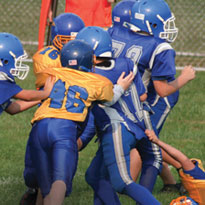Helping Coaches Brush Up on Sports Safety
By Grant Martin
 |
Changes to first-aid methods and a new understanding of head injuries puts increasing importance on coaches at all levels to ensure their training is up to date. |
In the small world of community sports, Joe is legendary. A caring, knowledgeable man who has proven his coaching ability over a 20-year period, Joe is the coach all parents want to lead their kids’ team. There’s just one problem: When it comes to treating certain sports injuries, there’s a good chance Joe is doing things wrong.
“There have been enormous changes in CPR and first-aid methods over the years,” explains Sandra Sims, Ph.D., an assistant professor in the UAB School of Education. “I’ve never known a coach who would intentionally harm a child, but unless that coach is certified in the current methods, there is no way to be sure he or she is aware of the proper way to treat injuries.”
At the UAB School of Education, future coaches are required to take a course in sports safety. But Sims says that the group with the highest numbers of players—and the most vulnerable athletes—lies beyond the reach of most certification and training efforts. “At the youth sports and recreational level, there is no governing body requiring that these coaches receive updated training,” says Sims. “They’re often begging for adults to volunteer, so you don’t want to do anything that could be an obstacle to that.”
With those volunteer coaches in mind, Birmingham orthopedic surgeon Larry Lemak, M.D., created the National Center for Sports Safety (NCSS) in 2001 to promote injury prevention and safety on all levels of youth sports. UAB teamed with the NCSS last summer to offer a three-hour safety workshop, providing an overview of the skills required for students to become certified coaches. In addition to the workshop, Sims says that coaches can find information and even a test on the NCSS Web site—www.sportssafety.org—to help educate them on safety issues. “There are so many things that can happen on a court or ball field, and conventional wisdom doesn’t always work,” says Sims. “This is why sports safety training is critical, especially for youth coaches. We want to ensure that all athletes will be safe.”